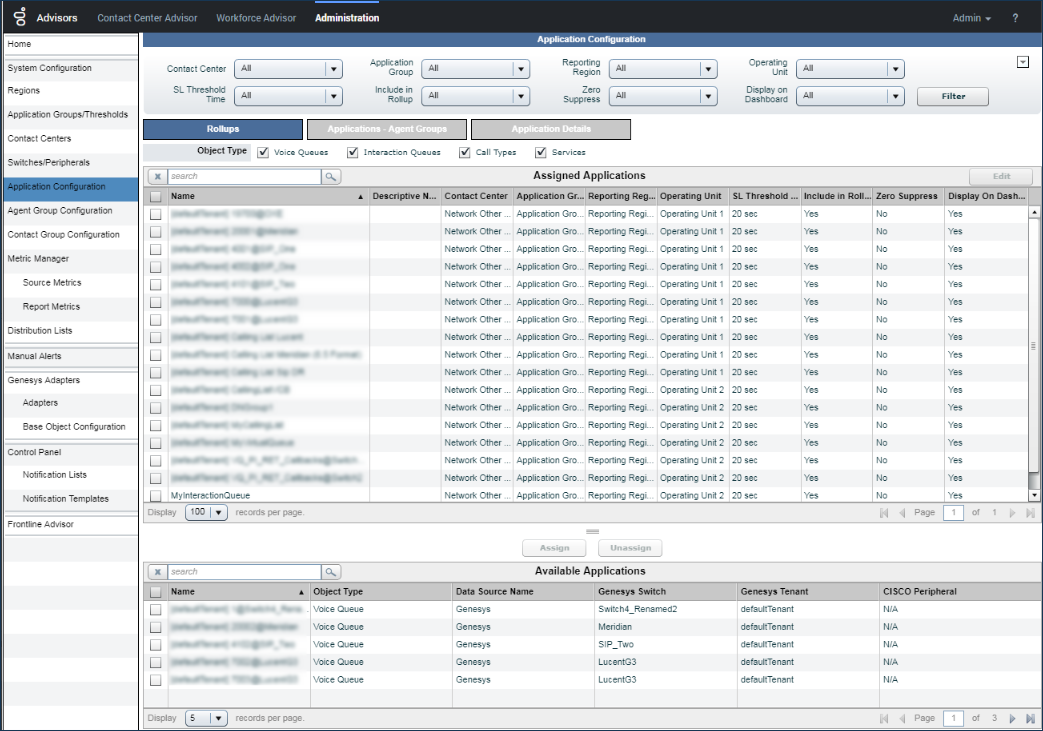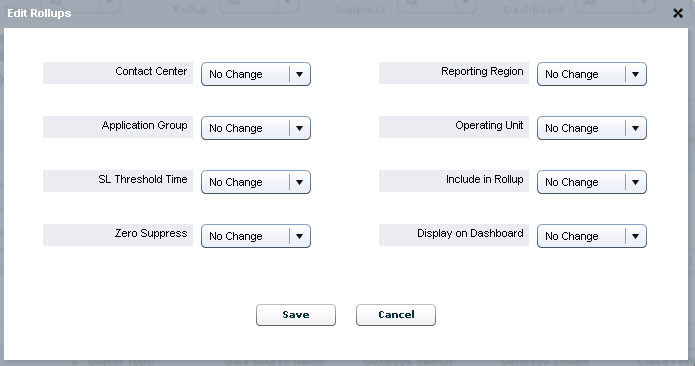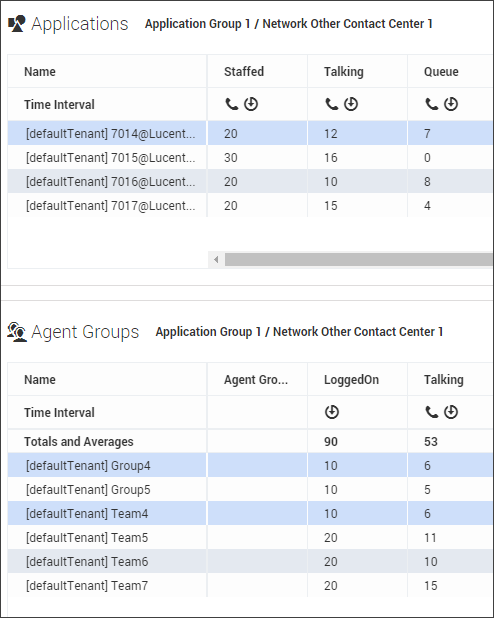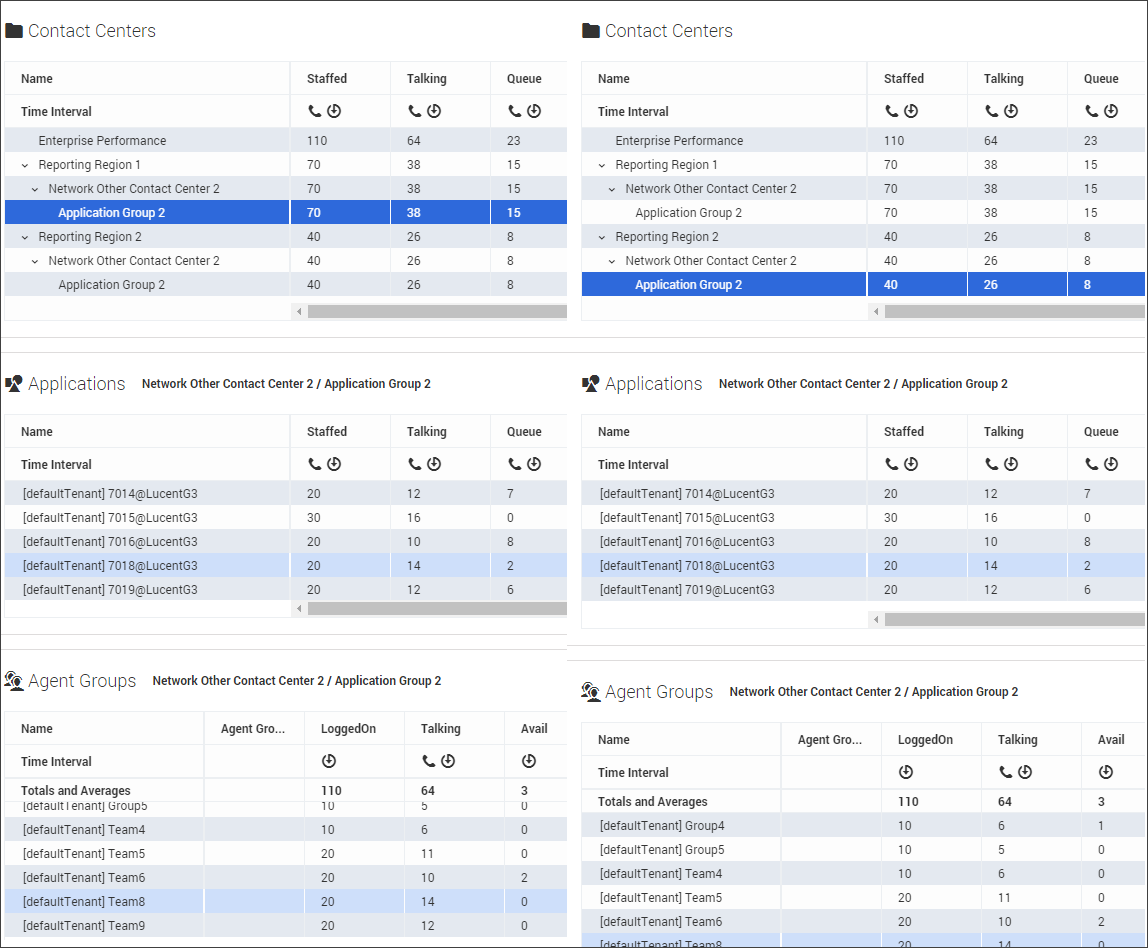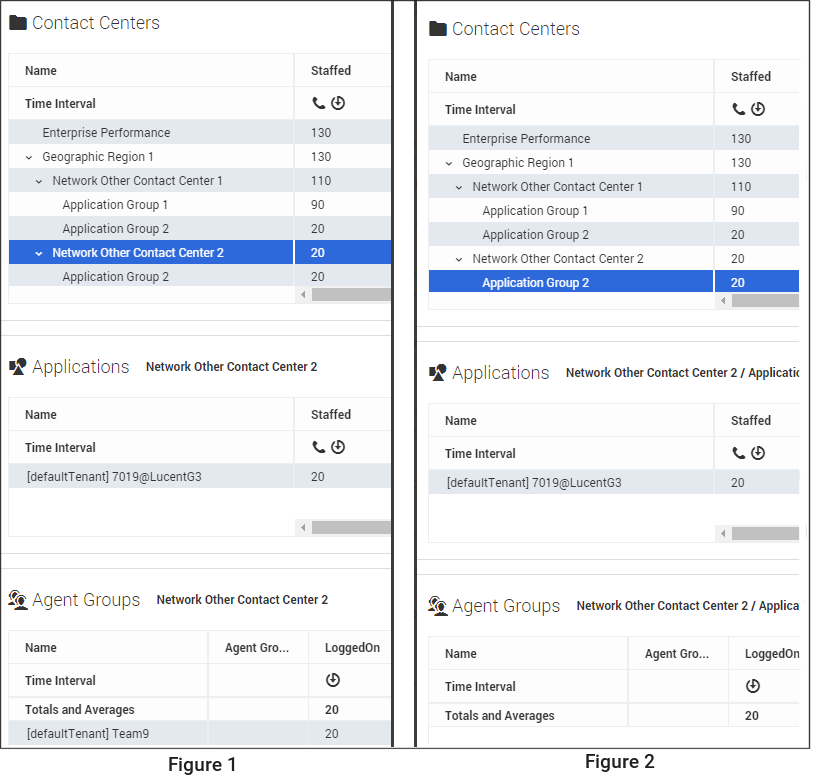Contents
- 1 Application Configuration
- 1.1 Using Advisors Filters Configuration to Segment Objects and Metrics
- 1.2 Rollups
- 1.3 Applications – Agent Groups tab
- 1.4 Application Details
- 1.5 Application SL Threshold Time Setting Can Override the Time Range Setting
- 1.6 Application-Agent Group Relationships Configuration and the CCAdv Dashboard
Application Configuration
The Application Configuration page is used for configuration of:
- Rollups (or aggregations)
- Associations between applications and agent groups
- Details of applications
35px|link= All CCAdv objects in the Configuration Server, such as queues, agent groups, interaction queues, calling lists, and DN Groups, to which you – the Configuration Server Advisors user – have access, are considered Base Objects. Starting with release 9.0, all queues, DN Groups, interaction queues, and calling lists that are configured in Genesys Configuration Server are available as applications on the Applications Configuration page, and all configured agent groups are available for mapping to the Advisors applications. You make changes to the base objects in the Configuration Server. After changes have been made to a base object, you can simply refresh the Application Configuration page in the administration module to pull the base object configuration changes into the administration module. A page refresh is also all that is required to pull in newly-configured base objects as available applications, or to remove applications from the list of available applications in cases where the base object was deleted in Configuration Server.
To configure the hierarchy displayed on the Contact Center Advisor (CCAdv) dashboard and to control how applications' metrics are rolled up, you need to create associations between:
- Applications and the business attributes, such as Contact Centers, Application Groups, Reporting Regions, and Operating Units
- Applications and agent groups
After these associations are established, the aggregation structure becomes available for CCAdv and WA rollup engines and for the Advisors dashboard hierarchy presentation mechanism. In the Advisors administration module, the associated applications and agent groups become visible on the Assigned Applications and Assigned Agent Groups panes of the Application Configuration page.
The lists of available applications and agent groups are automatically segmented when there is at least one object segmentation filter configured. Interaction queues and calling lists are excluded from the automatic filter segmentation as statistic filters are not generally applicable for interaction queue and calling list metrics.
There are no direct access permissions to applications or agent groups granted to the Advisors users. The visibility of the applications and agent groups on the dashboards is established through access to the business attributes associated with them. Data relating to or depending on business attributes to which users do not have any access permissions will not be displayed.
Access to Advisors business attributes must be configured by an administrator in the Configuration Server used in the Advisors installation.
The process of configuring applications that originate from different base objects is the same. There are, however, some specifics associated with the properties of the base objects that you must consider:
- Interaction queues and DN Groups are not associated with any specific switch. This means that the technical names of the applications originating from these base objects will not contain any switch name.
- DN Groups are, technically-speaking, aggregations of queues. DN Groups can aggregate queues that come from multiple switches. Genesys recommends that you avoid including both a DN Group and a queue (queues) aggregated by the DN Group in the Advisors rollup.
Using Advisors Filters Configuration to Segment Objects and Metrics
35px|link= Starting with release 9.0, the base objects that are available for configuration are automatically separated into one or more of the available object segmentation filters. Previously, the administration module included a Base Object Configuration page on which you configured the object-filter assignments.
In your Genesys configuration interface, you configure the filter as an Annex option on the filter attribute value. The Annex of a filter attribute value must contain a mandatory section called Filter. In this Filter section, you enter an option that defines the filter. Enter the filter expression in the Option Value field when you create the filter option. You can also add a NameFormat option to the Filter section to control the filter's display name for presentation purposes. If not specified, the filter's display name is the display name that you specified on the General tab.
If you plan to use a certain filter for application or agent group segmentation, then you must add an ObjectSegmentationFilter option to the Filter section of the corresponding filter in order to see the segmented applications or agent groups on the Available panes of the administration module's Application Configuration page. Once all applications and queues that need to be segmented with a given filter are configured, Genesys recommends that you remove the ObjectSegmentationFilter option from the filter business attribute. The presence or absence of the ObjectSegmentationFilter option in the filter business attribute has no impact on already-configured applications or agent groups, but its presence can create unnecessary overhead related to the display of available applications and agent groups in the administration module.
Only filters that include the ObjectSegmentationFilter Annex option are available to split applications and agent groups into filter segments. If you have filters that are created solely for the purpose of filtering some of the individual metrics, and not meant for segmenting the whole object, then there is no need to add the ObjectSegmentationFilter option on this type of filter. In other words, when the ObjectSegmentationFilter option is not included in the Filter section, that filter is not considered for object segmentation. Valid values for the ObjectSegmentationFilter option are yes/true and no/false.
The following figure shows the Filter section configuration for a filter attribute value.
Propagation of Changes Made to Filter Expressions
Any change that you make to a filter expression in Configuration Server is propagated to the Advisors Platform database immediately. Any new object that is added to the Rollup configuration after the change to the filter expression will automatically include the updated filter expression. However, the change to the filter is not immediately applied to the object filter segments that you have already configured. In that case, the changes are applied during the Advisors overnight refresh.
The pages in the Advisors administration module show available applications and agent groups in combination with all filters that have the ObjectSegmentationFilter option set to yes or true.
If you remove the ObjectSegmentationFilter option from a filter or setting the value to false/no , only the list of available applications and agent groups that are not yet added to the rollup configuration are impacted. All assigned applications and agent groups that are associated with this filter will remain intact until you manually remove them from assignment.
Rollups
The Rollups tab allows you to define how information displays, summarizes, expands, and contracts in the Contact Centers pane on the dashboard.
You assign a contact center, an application group, and a reporting region or operating unit to an application. These assignments are required for the application to display on the dashboard and to be included in the metric rollup for the specific grouping.
Starting with release 9.0, statistics requests are processed along with the process of configuring applications. In other words, statistics are requested for a Genesys application when the application is assigned to the rollup. The statistics requests for an application close when you remove the application from the application rollup.
You have the option to do bulk configuration of rollup relationships for CCAdv and WA. For information about bulk configuration, see the Pulse Advisors Deployment Guide.
Filtering the Display of Rollups
You can filter the list of objects in the Rollups display.
Filter by business object and other properties using the menus and the Filter button at the top of the page.
Filter by object type for a contact center using the check boxes that appear at the top of the Rollups tab.
- Voice Queues: For a Genesys data source, select the Voice Queues check box to display the virtual queues, ACD queues, and DN Groups.
- Interaction Queues: For a Genesys data source, select the Interaction Queues check box to display the interaction queues for chat and email.
- Call Types: For a CISCO data source, select the Call Types check box to display the call types.
- Services: For a CISCO data source, select the Services check box to display the services.
Sorting the Display of Rollups
To sort the data in the Rollup table, click a column heading. The arrow in the down or up position indicates which column is sorted.
Assign and Unassign Applications for Rollup
Procedure:
Steps
- Select Rollups.
Use the filter buttons at the top of the page to filter the displayed list of records.
Select one or more applications from the Available Applications table by checking their check box(es).
Click the Assign button. The screenshot shows the Assign Rollups dialog.
TipThe Assign Rollups dialog does not appear if the required related business attributes were already specified in the filter options. If only some of the mandatory objects are specified, then only the remaining missing ones need to be specified.Define the rollup by selecting the Contact Center, Application Groups, Operating Unit and/or Reporting Region for this application from the drop-down lists of options.
If you did not select a filter to display the data in the tables, the following defaults are applied:
- SL Threshold Time: 20 sec
- Zero Suppress: No
- Display on Dashboard: Yes
- Include in Rollup: Yes
If you did select a filter, then the values in the filter are applied.
Click Assign to save the changes.
To unassign an application, check its check box in the Assigned table, and click Unassign. No confirmation message is displayed.
Edit an Application Rollup
Procedure:
Steps
Select Rollups.
Use the filter buttons at the top of the page to filter the displayed list of records.
Select an application from Available Applications by checking its check box. You can select multiple applications in the same way. The changes you make will apply to all the applications you select. To navigate to the next or previous page, use the page controls.
Click Edit.
Use the drop-down lists on the Edit Rollups dialog to specify a value for each of the following:
- Contact Center
- Application Group
- SL Threshold Time
- Zero Suppress
- Reporting Region
- Operating Unit
- SL Threshold Time
- Include in Rollup
- Zero Suppress
- Display on Dashboard
If Include in Rollup is set to No and Display on Dashboard is set to Yes, the application’s metrics values will not contribute to rolled up values, but the application will still appear in the Applications pane when you select the appropriate grouping.
Genesys recommends selecting No for Include in Rollup and Yes for Display on Dashboard only for IVR/VRU-related applications in which you want to display IVR performance in the Applications pane, but not in the Contact Centers pane. The IVR should handle 100% of the calls and the performance could indicate whether or not this is happening or if there might be a problem. In this case, including these numbers in the rollup would inflate the performance of call handling by the agents.
For the violations triggered by threshold rules on an application’s metrics to display on the dashboard, you must select Yes for Include in Rollup.
ImportantYou cannot select an agent group contact center on the Application configuration rollup tab. The association of the application and an agent group contact center is created behind the scenes once you map agent groups to the application and then map the agent groups to the agent group contact center. To map agent groups to agent group contact centers, go to the Agent Group Configuration page.
Applications – Agent Groups tab
For agent groups to display on the dashboard, the application-to-agent group relationship must be created.
The Applications-Agent Groups tab allows you to maintain the associations between applications and agent groups. The screenshot shows the Applications – Agent Groups tab.
You can opt to display either descriptive or technical names of objects by clicking the Display Descriptive Names or Display Technical Names link.
To see the agent groups available to assign to an application, and those already assigned to it, select the application.
Only the agent groups from the same external data source display for the selected application.
You can reverse the order of display by selecting the relevant radio button. When the agent groups display in the left-most pane, select an agent group to see the applications available to assign to the agent group, and those already assigned to it.
![]() Starting with release 9.0, agent groups can be associated only with applications that are currently configured in the rollups. Statistics are requested for an agent group as soon as the agent group is assigned to a configured application. If an agent group is mapped to only one application, then the statistics requests are closed for that agent group as soon as you remove the relationship between it and the application. If you remove an application from the rollup before first removing the mapping between it and agent groups, then statistics requests are closed during the nightly update for each agent group that was mapped to that application and which is not mapped to any other application.
Starting with release 9.0, agent groups can be associated only with applications that are currently configured in the rollups. Statistics are requested for an agent group as soon as the agent group is assigned to a configured application. If an agent group is mapped to only one application, then the statistics requests are closed for that agent group as soon as you remove the relationship between it and the application. If you remove an application from the rollup before first removing the mapping between it and agent groups, then statistics requests are closed during the nightly update for each agent group that was mapped to that application and which is not mapped to any other application.
Maintaining Applications-Agent Groups Assignments
Multiple edits are not available for assigning lists of agent groups to lists of applications in the administration module. You must edit individual applications to associate with a list of agent groups, or individual agent groups to associate with a list of applications.
Procedure:
Steps
- Select the Applications-Agent Groups tab.
- Select an application or agent group from the left panel. This displays the already assigned applications or agent groups in the Assigned panel on the right. Applications or agent groups that are available for assignment appear in the Available panel.
- To move an object between the Available and Assigned panels, check its check box and click either the up or down arrow between the two panels.
- Click Save.
Application Details
You use the Application Details tab to maintain all the details of an application other than its technical name. The screenshot shows the Application Details tab.
Maintaining application details
Procedure:
Steps
- Click the Application Details tab.
- Edit the details as follows:
- Descriptive Name: Descriptive names display on the dashboard. Hovering over the descriptive name displays the technical name.
- SL Threshold Time: Applicable only to ACD queues, virtual queues and DN Groups. Select a value from the drop-down list. The list of available SL threshold times is predefined. To add additional entries to this list, new entries can be added to the Platform database table SL_THRESHOLD.
- Include in Rollup: Check the box to include the application in rollups.
In addition to this setting, the application must be configured, which means that it must be related to a contact center, application group, reporting region, and/or operating unit.
See Edit an Application Rollup for further information on this option. - Zero Suppress: Check the box to zero-suppress the application. (See Zero Suppression.)
- Display on Dashboard: Check the box to display the application on the user dashboard.
In addition to this setting, the application must be configured, which means it must be related to a contact center, application group, reporting region, and/or operating unit.
See Edit an Application Rollup for further information on this option.
- Click Save.
Application SL Threshold Time Setting Can Override the Time Range Setting
The SL Threshold Time set on the Application Configuration page overrides the Time Range setting at the application level for the default (out-of-box) Service Level metrics. The override is not applicable to custom Service Level metrics created for use in your enterprise. The Figure below shows the Time Range setting in the Report Metric Manager.
For information about changing the default Service Level threshold, see Change the Default Service Level Threshold Setting, which includes the list of default Service Level metrics.
Application-Agent Group Relationships Configuration and the CCAdv Dashboard
Certain specific dashboard functionality is activated when you configure relationships between:
- agent groups and applications
- applications and application groups or applications and contact centers
An application-agent group relationship is created when you assign an agent group to an application.
An application group-agent group relationship is created when you:
- Assign an agent group to an application that is related to an application group.
- Assign an application group to an application that is related to an agent group.
To delete an application-agent group relationship, remove the agent group from the application.
To delete an application group-agent group relationship, do one of the following:
- Remove the application group from all applications that are related to the agent group.
- Remove the relationship between the agent group and all applications that are related to the application group.
An agent group-contact center relationship is created when you:
- Assign an agent group to an application that is related to a contact center.
- Assign a contact center to an application that is related to an agent group.
To delete an agent group-contact center relationship, do one of the following:
- Remove the contact center from all applications that are related to the agent group.
- Remove the relationship between the agent group and all applications that are related to the contact center.
When you change object relationships as described above, there will be a delay in the presentation of the new relationships on the CCAdv dashboard. The CCAdv server checks for updates to this type of information only once each day, overnight. Until then, you will observe some inconsistencies in object relationships on the CCAdv dashboard. See the troubleshooting section, below, to find the sorts of inconsistencies that you can expect to see. Note, however, that there is no such delay related to metrics consistency when you update relationships as described above. Once the relationships are changed, the metric values that depend on the new relationships are correctly derived and displayed within a reasonable period of time.
Dashboard Functionality Dependent on Application-Agent Group Relationships
One of the features of the Contact Center Advisor dashboard is the ability to highlight relationships between objects. For example, selecting an application in the Applications pane should highlight, in the Agent Groups pane, the agent groups that are associated with that application. It is very important to correctly configure object relationships for the Advisors applications. Incorrect configuration of relationships in the administration module results in incorrect relationships on the users' dashboards.
Highlighting agent groups when applications are selected, and vice versa
Configuring correct relationships between applications and agent groups in the Advisors administration module supports the following dashboard functionality: when a user selects an application, the dashboard highlights the associated agent groups.
In the screenshot, you can see that selecting application 7014 in the Applications pane highlights the Group4 and Team4 agent groups in the Agent Groups pane on the CCAdv dashboard.
The reverse is also supported. When a user selects an agent group in the Agent Groups pane on the CCAdv dashboard, the dashboard highlights the associated application in the Applications pane.
In the following sample screenshot, selecting the Team4 agent group highlights application 7014 in the Applications pane. This indicates that Team4 is associated with the 7014 application.
Highlighting objects on the Contact Centers Pane
Configuring relationships between application groups and agent groups in the Advisors administration module determines which agent groups display in the Agent Groups pane when a user selects any kind of object at level 3 or level 2 in the Contact Centers pane. The screenshot shows the CCAdv Contact Centers pane, and identifies what we mean by levels 1, 2, and 3 in the hierarchy.
The type of objects that display at each level of the hierarchy is dependent on the hierarchical grouping that you selected at the top of the Contact Centers pane. The screenshot shows the ![]() hierarchical grouping on the left and the
hierarchical grouping on the left and the ![]() hierarchical grouping on the right.
hierarchical grouping on the right.
When a user selects an object of any kind at either level 3 or level 2 in the Contact Centers pane, the dashboard displays the agent groups and their related applications that are associated with the selected contact center and application group.
Note that all applications that belong to the selected contact center and application group are shown; the relationship to the level 1 grouping is ignored. For example, let's say that five applications are assigned to the same contact center, application group, and operating unit. Two of them are associated with Reporting Region 2 and the rest are associated with Reporting Region 1.
When the user selects Application Group 2 under either Reporting Region 1 or Reporting Region 2, the Applications pane shows, in both cases, all applications that belong to Application Group 2 and the related contact center.
Inconsistencies in Object Relationships on the CCAdv Dashboard
This section describes an object relationship display issue that dashboard users might experience, and provides information about the possible causes.
Issue
An agent group displays in the Agent Groups pane when the dashboard user selects an object on level 2 in the hierarchy (Figure 1, below), but does not display when that user selects the related object on level 3 in the hierarchy (Figure 2).
Possible Causes
- Inconsistent agent group display that is related to object selection in the CCAdv Hierarchy pane is a temporary state that can occur after a change in application-agent group relationships. When this is the cause, the inconsistency will go away during the overnight data update. If you do not want to wait overnight to see consistent results on the dashboard, and an application restart is allowed, then you – or an administrator with sufficient permissions – can restart the CCAdv XML Generator. The restart will reconcile all CCAdv dashboard presentation views based on the latest application-agent group relationship configuration. Note, however, that there is no such delay related to metrics consistency when you update the relationships. Once the relationships are changed, the metric values that depend on the new relationships are correctly derived and displayed within a reasonable period of time without any component restart or nightly update. For more information about Application-agent group relationships and their configuration, see Application-Agent Group Relationships Configuration and the CCAdv Dashboard, above.
- The primary CCAdv XML Generator application stopped running, and the backup application has taken over processing. The agent groups will be displayed for the object at level 3 in the hierarchy when the backup XML Generator reads the relationships during the overnight refresh.

